Power Capacitors for Renewable Energies

Wind power and photovoltaic systems are based on powerful AC-DC and DC-AC converters. They require reliable power capacitors for AC filtering and voltage stabilization in the DC link circuits. TDK offers a complete portfolio of power capacitors customized for these issues with a wide range of voltages and capacitances.
Contents
Overview
Renewable energy systems consist of multiple components, mechanical and electrical connections. They regulate and modify the electrical output. The generated electricity can be stored, used directly or fed into a large grid powered by central generating plants connected or tied to the grid.
The wind and solar inverters transforms DC to AC current. Power electronic designers are under increasing pressure to achieve higher power requirements with very high efficiencies, overvoltage and overcurrent protection due to switching failures, lightning, ground faults and safety regulations. Long-term stability and reliability is a furthermore issue.
TDK offers special products for many circuit functions, depending on the application requirements. Thus, its film based capacitor technology is particularly suitable for power electronics designers looking for proven performance.
- Higher rated voltages compared to other capacitor technologies
- High overvoltage capability due to their self-healing properties
- Low equivalent serial resistance (ESR) and inductance (ESL)
- High power operation (IRMS vs. frequency)
- Stability of electrical parameters over time and temperature
Schematic circuit
A typical renewable energy inverter needs DC link capacitors for the reduction of ripple current in the transformation from AC to DC voltage. Depending on the power electronic topology DC link capacitor can be used according to the electrical parameters needed.
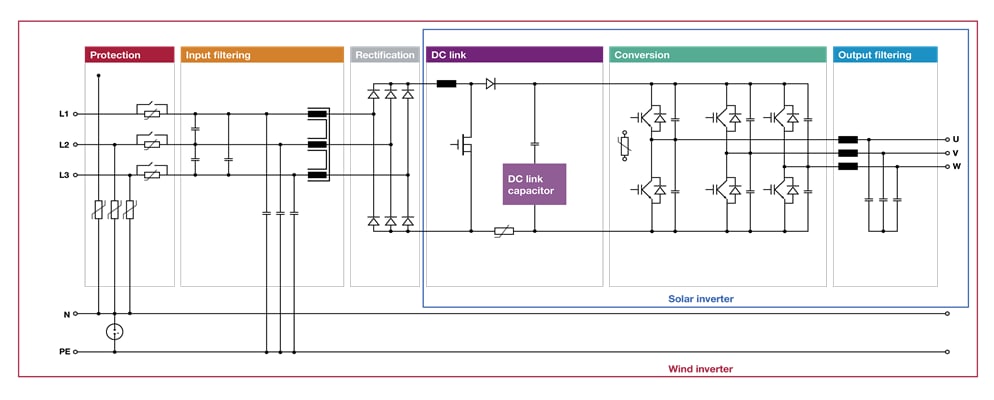
Feature comparison
| Type / Series |
MKP DC Standard | MKP DC Resin top | MKP DC Metal top | ModCap™ MF | ModCap™ HF |
|---|---|---|---|---|---|
| B2562* Series | B2569* Series | B2568* Series | B25645* Series | B25647* Series | |
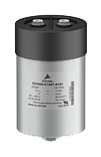 |
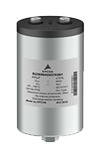 |
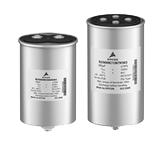 |
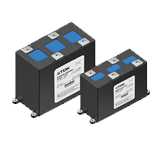 |
 |
|
| Rated capacitance (µF) | 40 - 4000 | 40 - 5500 | 60 - 4000 | 335 - 3900 | 660 - 1900 |
| Voltage (V DC) | 700 - 2000 | 700 - 3000 | 900 - 3000 | 900 - 2300 | 900 - 1600 |
| Temperature up to | 85 °C | 85 °C | 85 °C | 90 °C | 90 °C |
| ESL | < 20 nH possible (depending on H and D) |
< 20 nH possible (depending on H and D) |
< 10 nH (for 4 terminal capacitors) |
< 14 nH | 8 nH |
| Dimensions | 75, 85, 116 mm (D) 70...345 mm (H) |
75, 85, 100, 116, 136 mm (D) 95...370 mm (H) |
85, 116, 136 mm (D) 99...368 mm (H) |
205, 220 mm (L) 90, 115 mm (W) 170, 215 mm (H) |
205, 220 mm (L) 90, 115 mm (W) 170, 215 mm (H) |
| Standards | IEC 61071 UL recognized |
IEC 61071 UL recognized |
IEC 61071 | IEC 61071, IEC 61881-1 UL recognized |
IEC 61071, IEC 61881-1 UL recognized |
| EN 45545 | HL3 R23 (fire/smoke) | HL3 R23 (fire/smoke) | HL3 R23 (fire/smoke) | ||
| Case | Aluminum | Aluminum | Aluminum Hermetically sealed for harsh environment |
Plastic | Plastic |
Higher energy density and compactness
There is a clear market trend to have lighter and more compact inverters in order to optimize volume-weight ratio of the whole system.
This market trend is directly influencing the design of DC link capacitors, so compactness is a must.
Compactness of DC link capacitors may be achieved by optimizing the internal volume of the case by using the right winding technology and
increasing the field strength (V/µm), which is directly linked with the use of thinner films for the same nominal voltage.

Better efficiency for solar and wind inverters
-

Solar
Since PV is strongly influenced by cost pressure then new inverters are forced to offer very high efficiency of up to 98 percent with longer maintenance periods.
This application is demanding cost optimized standard products with reduced ESR and ESL. The capacitors should be optimized to work at higher frequencies. -
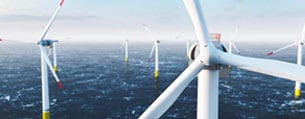
Wind
It is as well strongly influenced by cost pressure with a trend to increase nominal voltage (high power specially in off-shore application) and reduce weight, low ESR and ESL are important parameters .
Both applications are demanding higher current densities.





